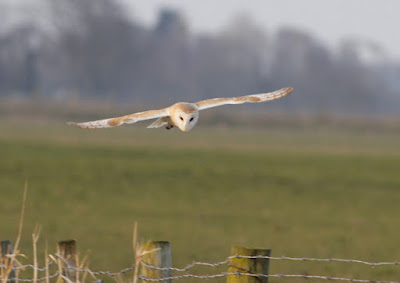Thursday, March 31, 2016
Finches Again
Friday, March 18, 2016
More Finch Tales
Linking today to Stewart's World Bird Wednesday, Anni's Birding and Eileen's Saturday.
Thursday, March 10, 2016
Trickle Time
We didn’t catch a single Goldfinch today and we both scratched our heads trying to remember the last time Goldfinch failed to appear on a field sheet from this site. Coal Tits are also regular here, mainly as recaptures from previous ringing sessions so we were surprised to catch three new ones today in our total of just 15 - 4 Lesser Redpoll, 2 Siskin, 2 Chaffinch, 3 Blue Tit, 3 Coal Tit and 1 Dunnock.
The normal habitat of the dipper is fast flowing streams, and although there are some nearby, to see a dipper along the reservoir’s margins made us look twice.
Linking today to Anni's Blog and Eileen's Saturday.
Saturday, February 27, 2016
An Owl Or Two, Or Three Or Four
Sunday, November 22, 2015
Sunday's Birds
With the preponderance of conifer trees here Coal Tits are ever present as their small bills allow them direct access to the tiny holes of the Nyger feeders. Meanwhile the Great Tit, Blue Tits and Chaffinches stay around so as to take food from the ground. We avoid the use of peanuts or mixed seed feeders and instead use Nyger feeders and ground feeding as a means of targeting the several species of finches which occur in this area.
In the meantime take a look at more birds Stewart's World Bird Wednesday.
Saturday, August 15, 2009
Hi everyone!
Well I did the easy bit. Signed up to The Bird Blog Club, swore my oath of allegiance to Google Inc and wrote down to later lose yet another unmemorable password variation on “wheat3£?22ear99”. Just two geeks who had a bright idea? There’s hope for birders yet. I’m just thankful I have a few quid invested with Google.
A blank screen, but now for the difficult bit, adding the words and pictures, desperately trying not to cock-up completely. Even so my hit counter is at 50 and more before I click the “publish” button. I managed to upload a header photo, even handled the obligatory bird links, slipping in a few extra non birdy ones, hoping it won’t lead to my further relegation to an even lower division. I quite like the header photo taken recently with my old Nikon Coolpix 8700, easily the worst camera I have ever had. If anyone wants to take this pile of poo off my hands before it lands in the big grey bin, or joins the mountain of pre digital camera equipment festering in a cupboard, let me know. But for now, thank goodness for the Footsie bounce, back to the digital age with a vengeance and a brand new Canon. All I need now is for autumn to begin, a few more birds than I have seen in recent weeks and I can snap away 600 times before loading a new film I’m told.
I agonised over the title. Unhelpful and a little puzzling that Sue said “Just call it ‘Victor’s’ Blog”, everyone will understand that”. “But it’s about birds” I insisted grumpily. Women, I don’t believe them.
So it’s just another bird blog with no firm plans, after all, Rome wasn’t built in a day, I’ll just take it as it comes whether I’m birding, ringing or whatever. I know I have to make it interesting for you to visit again; I don’t want this blog to suffer from McDonalds Syndrome - “Tried It Once, Never Again”. Pretty sure what won’t be on here – Weeds, Creepy Crawlies and Seawatching. Now there’s an apt name for a Fylde pastime. Which reminds me that I did have a lady at Knott End phone me this week to say she had a Gannet on her chimney all afternoon, but after being harassed by gulls for a few hours it apparently flew off to no doubt later excite the folks at Starr Gate.
Don’t get me wrong, when I lived on the other side of the River Wyre I used to go to Rossall Point quite a lot, mainly to keep an eye on the breeding Ringed Plover where in the 1980s and 1990s I found many nests, sent in many Nest Record Cards and ringed over 60 pulli. Now no one seems to know how Ringed Plovers do there or whether any still manage to breed after years of torment by the doggy brigade, ably supported by Wyre Borough Council. Also, I love watching Cory’s and yelkouans from “The Malibu” on Menorca, tossing the occasional lump of bocadillo to the lingering Audouin’s or Yellow-legged Gulls, but from the cliffs find it much more interesting to separate the Pallid from the Common or wait for the Alpine or a passing Hobby than stare out to sea.
Anyway, whilst typing away but glancing out of the window cursing yet another weather “forecast” as the sun peeks out, I realised that as its fine I really must get out to ring what will probably turn out to be my last Swallows of the year.
For now I’ll leave you with a few pictures from earlier in the year. Barn Owls near Nateby and Little Owls near Garstang, the latter courtesy of Wayne Sleep’s mum. Wow, this blog must get better and better, maybe I can get some birding celebrities and big listers on here next.














































.jpg)

















